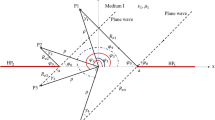Abstract
The problem of diffraction of an optical wave by a 2D periodic metal aperture array with square, circular, and ring apertures is solved with allowance for the finite permittivity of a metal in the optical band. The correctness of the obtained results is verified through comparison with experimental data. It is shown that the transmission coefficient can be substantially greater than the corresponding value reached in the case of diffraction by a grating in a perfectly conducting screen.
Similar content being viewed by others
References
L. Salomon, F. Grillot, A. Zayats, and F. de Fornel, Phys. Rev. Lett. 86, 1110 (2001).
L. Martin-Moreno, F. J. Garcia-Vidal, and H. J. Lezec, Phys. Rev. Lett. 86, 1114 (2001).
U. Schroter and D. Heitmann, Phys. Rev. B 58, 15419 (1998).
J. Vuckovic, M. Loncar, and A. Scherer, IEEE J. Quantum Electron. 36, 1131 (2000).
S. Shinada, J. Hashizume, and F. Koyama, Appl. Phys. Lett. 83, 836 (2003).
P. A. Hobson, J. A. E. Wasey, I. Sage, and W. L. Barnes, IEEE J. Sel. Top. Quantum Electron. 8, 378 (2002).
E. Popov, M. Nevière, S. Enoch, and R. Reinisch, Phys. Rev. B 62, 16100 (2000).
L. A. Vainshtein, Theory of Diffraction and the Factorization Method (Sovetskoe Radio, Moscow, 1966) [in Russian].
A. M. Lerer, V. V. Makhno, P. V. Makhno, and A. A. Yachmenov, Radiotekh. Elektron. (Moscow) 52, 424 (2007) [J. Commun. Technol. Electron. 52, 399 (2007)].
D. E. Zelenchuk, A. M. Lerer, V. V. Makhno, and P. V. Makhno, Elektromagn. Volny Elektron. Sist. 12(6), 41 (2007).
I. A. Kaz’min, A. M. Lerer, and V. N. Shevchenko, Radiotekh. Elektron. (Moscow) 53, 191 (2008) [J. Commun. Technol. Electron. 53, 177 (2008)].
Additional information
Original Russian Text © D.E. Zelenchuk, I.A. Kaz’min, A.M. Lerer, V.V. Makhno, P.V. Makhno, 2009, published in Radiotekhnika i Elektronika, 2009, Vol. 54, No. 4, pp. 418–422.
Rights and permissions
About this article
Cite this article
Zelenchuk, D.E., Kaz’min, I.A., Lerer, A.M. et al. Solving the problem of diffraction of an optical-band electromagnetic wave by metal nanostructured aperture arrays with the use of the method of impedance boundary conditions. J. Commun. Technol. Electron. 54, 399–403 (2009). https://doi.org/10.1134/S1064226909040044
Received:
Published:
Issue Date:
DOI: https://doi.org/10.1134/S1064226909040044



